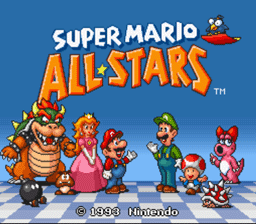Overview
 Super Mario All-Stars Title Screen.
Super Mario All-Stars Title Screen.Super Mario All-Stars is a game developed by Nintendo and released on the Super Nintendo Entertainment System in 1993. The title was designed as a definitive collection of four previous Mario titles that had been released on the original NES. Thanks to the enhanced capabilities of the SNES over its predecessor, each of the Mario games appeared with graphical face lifts, adding more detailed graphics and animation, as well as remixed soundtracks. The game also includes a save system, allowing the player to save their progress before quitting.
The titles included in Super Mario All Stars are:
Additionally, Nintendo released an updated version of the game in North America in 1994 as an SNES pack-in game. This new version included the four previously listed games as well as the SNES launch title Super Mario World. This version is titled Super Mario All-Stars & Super Mario World.
The Lost Levels
![The Japanese Super Mario Bros. 2 is included under the title]() The Japanese Super Mario Bros. 2 is included under the title "The Lost Levels."
The Japanese Super Mario Bros. 2 is included under the title "The Lost Levels."Super Mario Bros.: The Lost Levels is the original Japanese version of Super Mario Bros. 2. It wasn't released in North America until its inclusion in Super Mario All-Stars. The North American Super Mario Bros. 2, a heavily modified and redesigned version of the game Yume Kojo: Doki Doki Panic, had previously been released in Japan under the name Super Mario USA. As a proper sequel built from the foundation set by the original Super Mario Bros., The Lost Levels contains many of the same design aesthetics and gameplay aspects, but with a much greater degree of challenge. It also removed the option of a two-player game but allowed players to play as either Mario or Luigi, and gave the brothers different abilities. While Mario controls essentially the same as he did in the first game, Luigi is given a much higher jump at the cost of less traction on the ground.
Nintendo Wii Release
 Box art for the Wii's Anniversary Edition.
Box art for the Wii's Anniversary Edition.In 2010, Super Mario All-Stars was rereleased on the Wii to commemorate the twenty-fifth anniversary of the original Super Mario Bros. The game was notable as it was the only way to play the updated versions of the games on the Wii. (The virtual console version of the games are just ports of the NES version) In addition to the game, the package also included a thirty-two page booklet containing artwork and comments from Nintendo staff members and a CD containing tracks from games ranging from the original Super Mario Bros. to Super Mario Galaxy 2. The album also contains ten original sound effects and short music clips from the original game, including the coin-collection sound effect, the power up/power down sounds, and the Game Over theme. The pack was released in Japan on October 21, 2010, in Europe on December 3, 2010, and in the U.S. on December 12, 2010.
The content of this edition of Super Mario All-Stars is identical to its original 1993 release. It can be played using either the Wii Remote by itself, a Classic Controller, or a GameCube controller, though all in-game controller graphics still reference the standard SNES controller.
On February 15, 2011, after nearly two million copies sold worldwide, Nintendo announced it would do one final run of Super Mario All-Stars for the Wii. This last run shipped to retailers in North America on March 13, 2011.
Super Mario History 1985-2010 Soundtrack CD

Included in the Wii release of the title is a soundtrack CD. Notably, the box art makes note that "this Audio Compact Disc cannot be played on the Wii console".
- Super Mario Bros. (Ground Theme)
- Super Mario Bros. 2 (Ground Theme)
- Super Mario Bros. 3 (Athletic Theme)
- Super Mario World (Ground Theme)
- Super Mario 64 (Slider)
- Super Mario Sunshine (Delfino Plaza)
- New Super Mario Bros. (Main Theme)
- Super Mario Galaxy (Main Theme)
- New Super Mario Bros. Wii (Title Theme)
- Super Mario Galaxy 2 (Main Theme [Trailer Arrangement])
- Super Mario Bros. (Coin)
- Super Mario Bros. (Small Mario Jump)
- Super Mario Bros. (Power-Up)
- Super Mario Bros. (1-Up)
- Super Mario Bros. (Pipe Travel / Power-Down)
- Super Mario Bros. (Hurry Up)
- Super Mario Bros. (Lost a Life)
- Super Mario Bros. (Game Over)
- Super Mario Bros. (Course Clear)
- Super Mario Bros. (World Clear)
Log in to comment